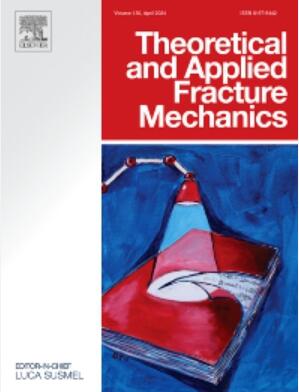Analysis of compact tension specimens with deflected cracks for orthotropic materials
IF 5
2区 工程技术
Q1 ENGINEERING, MECHANICAL
引用次数: 0
Abstract
Anisotropic materials, such as alloy, wood and fiber-reinforced composites, are widely used in load-bearing components. Accurately obtaining its fracture performance is crucial for safety assessment. However, existing testing methods based on compact tension (CT) specimen have not taken into account material anisotropic characteristics and crack deflection. In this work, the systematic finite element analysis (FEA) was conducted for CT specimens with deflected cracks made of orthotropic materials. A wide range of geometric (crack deflection angle, β, and ratio of crack length to width, ap/W) and orthotropic material (λ and ρ) parameters were discussed. Complete solutions of the stress intensity factor (KI and KII) and load-line compliance (C) were determined for the first time. The results showed that the geometric dimensions and material parameters have a significant coupling influence on the fracture parameters. The influence of the λ is generally greater than that of the ρ. Changes of material parameters can make fracture parameters’ dependence on β vary. The variation of β and ap/W could enlarge or minish even dismiss the impact of λ and ρ. In addition, to further verify the importance of the obtained fracture parameters, the CT fracture tests of carbon fiber-reinforced epoxy resin under various orientations were conducted. The solutions will promote the optimization of the fracture toughness testing standards for CT specimens made of anisotropy materials.
正交各向同性材料带偏转裂缝的紧凑拉伸试样分析
合金、木材和纤维增强复合材料等各向异性材料被广泛用于承重部件。准确获取其断裂性能对于安全评估至关重要。然而,现有的基于紧凑拉伸(CT)试样的测试方法并未考虑材料的各向异性特征和裂纹挠度。在这项工作中,我们对正交各向异性材料制成的带偏转裂纹的 CT 试样进行了系统的有限元分析(FEA)。讨论了多种几何参数(裂纹偏转角 β 和裂纹长宽比 ap/W)和正交材料参数(λ 和 ρ)。首次确定了应力强度因子(KI 和 KII)和负载线顺应性(C)的完整解。结果表明,几何尺寸和材料参数对断裂参数有显著的耦合影响。材料参数的变化会使断裂参数对 β 的依赖性发生变化。此外,为了进一步验证所得断裂参数的重要性,还对碳纤维增强环氧树脂进行了不同取向的 CT 断裂试验。这些解决方案将促进各向异性材料 CT 试样断裂韧性测试标准的优化。
本文章由计算机程序翻译,如有差异,请以英文原文为准。
求助全文
约1分钟内获得全文
求助全文
来源期刊

Theoretical and Applied Fracture Mechanics
工程技术-工程:机械
CiteScore
8.40
自引率
18.90%
发文量
435
审稿时长
37 days
期刊介绍:
Theoretical and Applied Fracture Mechanics'' aims & scopes have been re-designed to cover both the theoretical, applied, and numerical aspects associated with those cracking related phenomena taking place, at a micro-, meso-, and macroscopic level, in materials/components/structures of any kind.
The journal aims to cover the cracking/mechanical behaviour of materials/components/structures in those situations involving both time-independent and time-dependent system of external forces/moments (such as, for instance, quasi-static, impulsive, impact, blasting, creep, contact, and fatigue loading). Since, under the above circumstances, the mechanical behaviour of cracked materials/components/structures is also affected by the environmental conditions, the journal would consider also those theoretical/experimental research works investigating the effect of external variables such as, for instance, the effect of corrosive environments as well as of high/low-temperature.
 求助内容:
求助内容: 应助结果提醒方式:
应助结果提醒方式:


